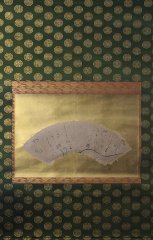MOUNTING
|
|
|
|
The Art of Mounting Chikako Fukami Thomsen works with renowned Japanese mounters to create the fitting contexts for her works. The East Asian mount is not merely a frame on a painting, in the sense of the western tradition, but a collaboration between the original artwork and that of the mounter, who becomes an artist in his own right. Famous painters and calligraphers in Japan and China’s past have worked closely together with their own mounter, in order to create just the right combination of colors, silk types, mounting styles and other factors that are included in the complex decisions of the mount. There exists also an old tradition of famous mounters, who not only work with contemporary artists, but also act as conservators and restorers of old works of art. In a sense the East Asian mounter is a combination of various skills that are typically held by different specialists in the West: the art director, the restorer, the conservator, the mount maker, and the frame specialist. Just as living artists choose out and work with a certain mounter, so the art collectors, museums and temples choose out their mounter to take care of their old works of art. As East Asian mounts have to be replaced every 80-100 years, there is a continuing act of restoring and remounting, an act that has to be entrusted to only the best mounters, who are left in charge of priceless treasurers of these collectors and institutions. *** This tradition is also a part of the art produced by Chikako Fukami Thomsen. She carefully selects her mounters and has worked with them for years. Two in particular stand out: Nakayama Shôbundô and Kitaoka Gihôdô, both are mounting workshops of the finest reputation that have been handed down for generations. Details on both can be found here: Nakayama Shôbundô Located in Otsu, close to the ancient capital of Kyoto, this workshop was founded in the Meiji period (1867-1912) and is presently run by the fourth generation master Nakayama Ryûhei. The Nakayama Gihôdô has long worked on mounting and restoration of painting collections of leading museums and temples in the Kyoto area, among them the famous painting collection of the Ishiyama Temple. Kitaoka Gihôdô Situated close to World Heritage Site Shimogamo Shrine in Kyoto, Kitaoka Gihôdô carries on the same name as the workshop originally founded in Yokkaichi by Kitaoka Ken. The workshop is now run by Kitaoka Hideyoshi and it works on objects owned by the most discerning domestic and foreign customers. Backing up this reputation is a long and distinguished record of successful restoration, primarily of Japanese paintings. Kitaoka Hideyoshi’s eldest son Kitaoka Hiroyuki is already an expert mounter, while his younger son, Kitaoka Yoshiyuki, is currently in training. In addition, Kitaoka Gihôdô has an English language website, that explains the importance of the mount (or hyôgu, as it is called in Japanese): As Mr. Kitaoka says: “A bare piece of calligraphy or painting cannot be preserved or appreciated by itself. The craft of hyôgu is dedicated to protecting and displaying various works of art so that their beauty may be enjoyed for a long time to come. Among the techniques at the hyôgu master’s disposal are those for restoration of damaged paper or frames, so that an artwork’s beauty may be preserved and rejuvenated.” |
***

